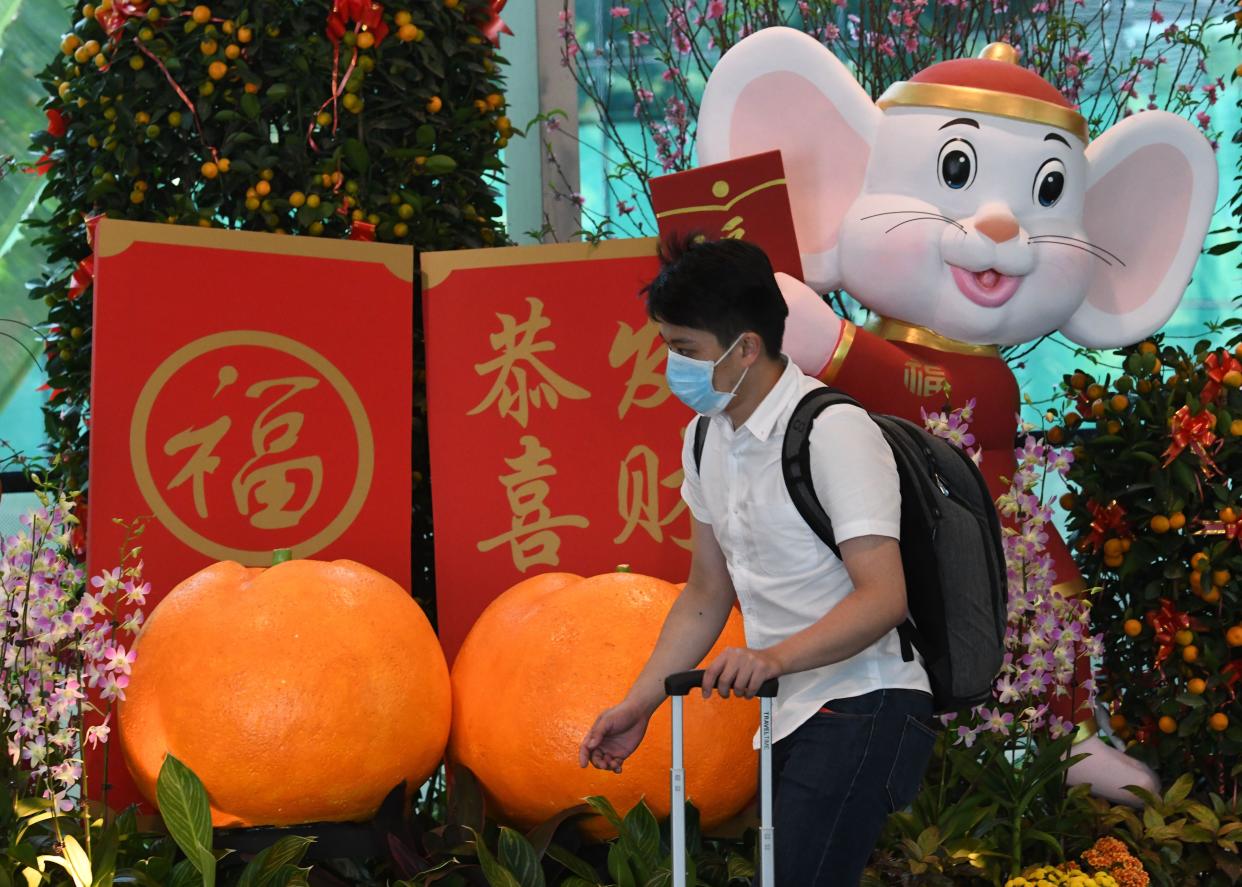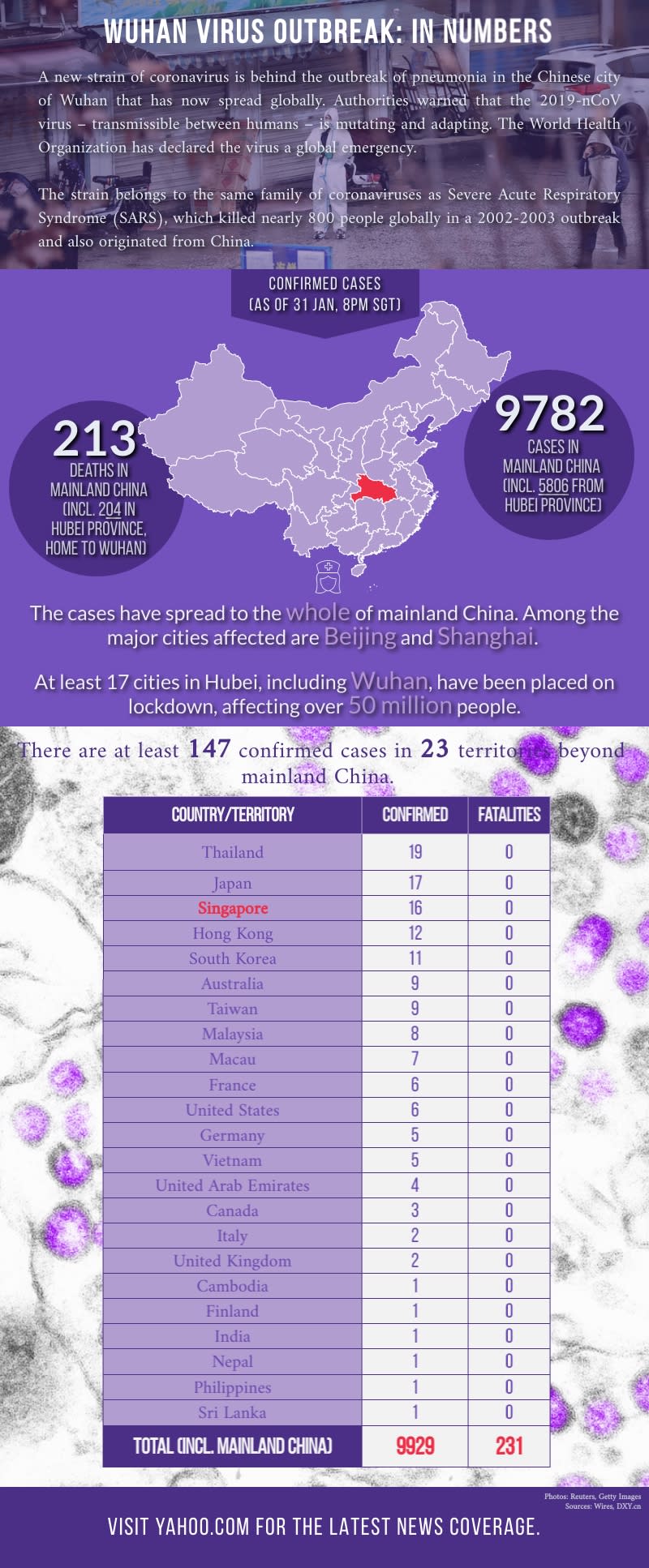Wuhan virus: 1st Singaporean among 3 new cases, total at 16

SINGAPORE — A 47-year-old female is the first Singaporean to be infected with the Wuhan coronavirus in the city state.
The Ministry of Health (MOH) confirmed three more cases of the virus, including the Singaporean, on Friday (31 January). This brings the total tally in the Republic to 16.
The other two new cases are Chinese nationals. In fact, 15 of the 16 confirmed cases are Chinese nationals, with at least 11 of them hailing from Wuhan.
The ministry said that there is currently no evidence of community spread in Singapore.
The 47-year-old Singaporean woman and her family had travelled to Wuhan, the epicentre of the outbreak. She was one of the 92 Singaporeans who were evacuated from the city on Thursday, and arrived in Singapore on the same day.
She was asymptomatic when she boarded the flight. Upon arrival at Changi Airport, she was found to have a fever during medical screening, and was conveyed to the National Centre for Infectious Diseases (NCID). She was tested positive for the virus infection on Friday at about 2pm and is currently warded in an isolation room at NCID.
The other case is a 31-year-old male Chinese national who is a Singapore Work Pass holder. After a trip to Hubei, he arrived in Singapore from Wuhan last Sunday. The man, who is currently warded in an isolation room at NCID, was tested positive for the virus on Thursday at about 11pm.
Another case is a 38-year-old male Chinese national who arrived in Singapore from Wuhan on 22 January. He was tested positive for the virus on Friday at about 2pm. He is currently warded in an isolation room at Singapore General Hospital.
Separately, the ministry provided more details on a case, a 73-year-old female Chinese national and a close contact of the second confirmed case, who was confirmed on Thursday.
The woman had arrived in Singapore from Wuhan on 21 January and reported that she was asymptomatic during her flight to Singapore.
The ministry said multiple attempts to contact her were made immediately and she was located on 28 January, having reportedly developed symptoms on the same day.
She was conveyed by an ambulance to NCID, where she was immediately isolated. She tested positive for the virus on Thursday at about 2pm.
Prior to her hospital admission, she stayed at ParkRoyal Collection Pickering (3 Upper Pickering Street) and Oasia Hotel Downtown (100 Peck Seah Street). She indicated that she had visited Changi Airport and Jewel, and had travelled on private transport and taxi.
All cases remain in stable condition, and most are improving.
Apart from the 16 confirmed cases, 198 of the suspect cases have tested negative for the Wuhan coronavirus, while test results for the remaining 35 cases are pending, as of Friday afternoon.
MOH has identified 202 close contacts as of Friday, 12pm. Of the 162 who are still in Singapore, 156 have been contacted and are being quarantined or isolated, while efforts are ongoing to contact the remaining six close contacts.
This makes Singapore the third country with the highest number of confirmed cases outside mainland China, behind Thailand and Japan. The novel coronavirus, or 2019-nCoV, has spread to 23 territories beyond mainland China, sickening close to 10,000 people and claiming the lives of 231.
The World Health Organization declared a global emergency over the new coronavirus on early Thursday (GMT), after initially downplaying the threat posed by the disease.
Travel ban
On Friday, the Multi-Ministry Taskforce on the Wuhan virus outbreak announced expanded travel curbs in a bid to contain the outbreak.
All China passport holders not residing in Singapore will be barred from entering or transiting through Singapore.
With immediate effect, the Immigration and Checkpoints Authority will suspend the issuance of all forms of new visas to those with China passports. Singapore’s status as a visa-free transit facility for those with China passports will also be suspended.
Previously issued short-term and multiple-visit visas for those with China passports will also be suspended. During this period of suspension, they will not be allowed entry into Singapore.
All new visitors with recent travel history to mainland China within the last 14 days will not be allowed to enter or transit through Singapore, said the Taskforce.
Returning Singaporeans and long-term visa pass holders with similar recent travel history will be allowed to enter, but they will have to get 14 days of Leave of Absence upon returning.
The curbs will take effect on Saturday at 23.59pm.
On Tuesday, the Taskforce announced an earlier set of travel curbs for visitors who had visited Hubei province, home to Wuhan.
Affected passengers who give false or inaccurate information in their travel history may be subject to penalties under the Infectious Diseases Act. A person who is convicted under the Act could be jailed up to six months and/or fined up to $10,000.
MOH has already started contract tracing for recent travellers to Hubei who are already in Singapore. There are an estimated 2,000 of them, with about 1,000 on short-term visas. Should they be assessed to be of high risk, they will be quarantined.
Returning Singaporeans, permanent residents and long-term pass holders with travel history to Hubei in the last 14 days will be quarantined, as will returning permanent residents and long-term pass holders with Chinese passports issued in Hubei.
On Thursday, 92 Singaporeans arrived home safely from Wuhan via Scoot flight TR121.
Separately, the MOH has advised Singaporeans to defer all travel to Hubei, and all non-essential travel to mainland China.
The novel strain belongs to the same family of coronaviruses as Severe Acute Respiratory Syndrome (SARS), which killed nearly 800 people globally during a 2002-2003 outbreak and also started in China.
It likely originated from Wuhan’s Huanan Seafood Market, where live animals or products – such as foxes, wolf puppies, giant salamanders, snakes, porcupines, and camel meat – are sold.
Patients suffering from the new strain may exhibit fever and symptoms of lower respiratory illness – such as coughing or difficulty in breathing –, as well as pneumonia-like symptoms like a runny nose, sore throat, and headache.
However, some who have died from it have not displayed symptoms of fever according to details released by China’s National Health Commission, potentially complicating global efforts to check for infected travellers as they arrive at airports and other travel hubs.
This means that temperature screening, the most common measure being used at transport links and airports to check travellers, may not identify some infected people.


Click here for more stories on the developing Wuhan virus crisis: sg.news.yahoo.com/health
Related stories:
Ministerial statements on Wuhan virus outbreak to be delivered in Parliament on Monday
Wuhan virus: MTI, MOH issue correction directions over fake news
Wuhan virus: MOE urges those on leave to be 'responsible'
Wuhan virus: 3 more confirmed cases in Singapore, total at 13
Wuhan virus: The Singaporeans who chose to remain in Hubei
Wuhan virus: Pack of 4 face masks to be distributed to each of 1.3 million households
3 in 5 Singaporeans fearful of contracting Wuhan virus: survey



